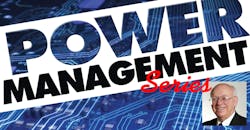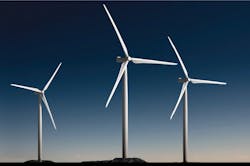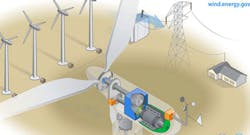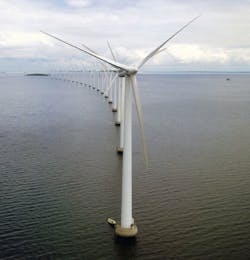This articles is part of the Power Management Series in the Power Management section of our Series Library.
Download this article as a .PDF eBook.
Wind power, as an alternative to burning fossil fuels, is plentiful, renewable, widely distributed, clean, produces no greenhouse gas emissions during operation, and uses little land. The net effects on the environment are far less problematic than those of nonrenewable power sources.
Wind power is very consistent from year to year, but has significant variation over shorter time scales. It is therefore used in conjunction with other electric power sources to give a reliable supply. As the proportion of wind power in a region increases, a need to upgrade the grid, and a lowered ability to supplant conventional production can occur.
Wind farms consist of many individual wind turbines connected to the electric power transmission network (Fig. 16-1). Onshore wind is an inexpensive source of electricity, competitive with or in many places cheaper than coal or gas plants. Offshore wind is steadier and stronger than on land, and offshore farms have less visual impact, but construction and maintenance costs are considerably higher. Small onshore wind farms can feed some energy into the grid or provide electricity to isolated off-grid locations.
16-1. Typical wind farm.
Wind turbines (Fig. 16-2) operate on a simple principle. The energy in the wind turns two or three propeller-like blades around a rotor. The rotor is connected to the main shaft, which spins a generator to create electricity. The wind turns the blades, which spin a shaft, which connects to a generator and makes electricity.
16-2. Typical wind turbine.
A typical electrical circuit for a wind-turbine installation includes generator, storage batteries, and charge controller. The ac output normally goes to a local transformer station (that collects all the turbines’ outputs), it is then transformed to a higher voltage and transmitted via a cable or overhead line to an infeed point (another transformer station), where the connection to the normal power grid is made. When being connected to the grid, this voltage must be synchronized with the utility grid.
Wind is actually a form of solar energy and is a result of the uneven heating of the atmosphere by the sun, the irregularities of the earth’s surface, and the rotation of the earth. Wind flow patterns and speeds vary greatly across the United States and are modified by bodies of water, vegetation, and differences in terrain. Humans use this wind flow, or motion energy, for many purposes: sailing, flying a kite, and even generating electricity.
Horizontal-axis wind turbines typically either have two or three blades. These three-bladed wind turbines are operated “upwind,” with the blades facing into the wind.
Utility-scale turbines range in size from 100 kilowatts to as large as several megawatts. Larger wind turbines are more cost-effective and are grouped together into wind farms, which provide bulk power to the electrical grid. In recent years, there has been an increase in large offshore wind installations in order to harness the huge potential that wind energy offers off the coasts of the U.S.
Single small turbines, below 100 kilowatts, are used for homes, telecommunications dishes, or water pumping. Small turbines are sometimes used in connection with diesel generators, batteries, and photovoltaic systems. These systems are called hybrid wind systems and are typically used in remote, off-grid locations, where a connection to the utility grid is not available.
Today, most turbines use variable speed generators combined with partial- or full-scale power converter between the turbine generator and the collector system, which generally have more desirable properties for grid interconnection and have low-voltage ride-through capabilities. Modern concepts use either doubly fed machines with partial-scale converters or squirrel-cage induction generators or synchronous generators (both permanently and electrically excited) with full-scale converters.
Power-management techniques such as having excess capacity, geographically distributed turbines, dispatchable backing sources, sufficient hydroelectric power, exporting and importing power to neighboring areas, using vehicle-to-grid strategies or reducing demand when wind production is low, can in many cases overcome these problems. In addition, weather forecasting permits the electricity network to be readied for the predictable variations in production that occur.
In a wind farm, individual turbines are interconnected with a medium voltage (often 34.5 kV), power-collection system, and communications network. At a substation, this medium-voltage electric current is increased in voltage with a transformer for connection to the high-voltage electric power transmission system.
One of the biggest current challenges to wind-power-grid integration in the United States is the necessity of developing new transmission lines to carry power from wind farms, usually in remote, lowly populated states in the middle of the country due to availability of wind, to high-load locations, usually on the coasts where population density is higher. The current transmission lines in remote locations were not designed for the transport of large amounts of energy. As transmission lines become longer, the losses associated with power transmission increase, as modes of losses at lower lengths are exacerbated and new modes of losses are no longer negligible as the length is increased, making it harder to transport large loads over large distances.
However, resistance from state and local governments makes it difficult to construct new transmission lines. Multi-state power-transmission projects are discouraged by states with cheap electricity rates for fear that exporting their cheap power will lead to increased rates. A 2005 energy law gave the Energy Department authority to approve transmission projects states refused to act on, but after an attempt to use this authority, the Senate declared the department was being overly aggressive in doing so. Another problem is that wind companies find out after the fact that the transmission capacity of a new farm is below the generation capacity, largely because federal utility rules to encourage renewable energy installation allow feeder lines to meet only minimum standards. These are important issues that need to be solved, as when the transmission capacity does not meet the generation capacity, wind farms are forced to produce below their full potential or stop running all together, in a process known as curtailment. While this leads to potential renewable generation left untapped, it prevents possible grid overload or risk to reliable service.
Offshore Wind Power
The near-term technology is still immature, which is an obstacle to offshore wind development (Fig. 16-3). High cost of wind energy can, in part, be addressed directly with technology innovations that increase reliability and energy output and lower system capital expenses. The current technology limits the domain for offshore machines to shallow-water sites at a cost premium that is reflective of the industry’s early state. New technology is needed to lower costs, increase reliability and energy production, solve regional deployment issues, expand the resource area, develop infrastructure and manufacturing facilities, and mitigate known environmental impacts. Because of the high up-front investment costs required to explore new technology innovation and the long timeline that is usually required to reap the full benefits of high-risk game-changing innovations, many companies may not be motivated to invest in R&D for offshore wind.
16-3. Offshore wind farm.
Shallow water is defined in this study as between 0 m and 30 m. This definition captures the water depth of most of the projects installed today, as well as the bulk of industry experience. Transitional depths range between 30 m and 60 m. Beyond 60 m in depth, several floating concepts derived from the oil and gas industry have been developed.
As a caution, note that the above-water depth bands for shallow, transitional, and deep water are specific to offshore wind turbines and are not derived from the oil and gas vocabulary, where deep water can mean 2,000 m or more. In addition, these depth bands only approximate the break points for the three technologies, but not enough experience exists to know if they are chosen accurately. They serve as good guides, though, for estimating the resource and the need to develop new solutions.
As water depth increases, the cost of offshore substructures is likely to increase because of the added complexity of design, fabrication, and installation, as well as the additional materials needed below the waterline. Rising costs resulting from water depth may appear in stages as technology limits are reached. Industry trends indicate that technology solutions might be able to mitigate these jumps for the specific site characteristics as the industry gains experience.
A transmission line is required to bring the generated power to (often remote) markets. For an off-shore plant, this may require a submarine cable. Construction of a new high-voltage line may be too costly for the wind resource alone, but wind sites may take advantage of lines installed for conventionally fueled generation.
Capacity Factor
Since wind speed is not constant, a wind farm’s annual energy production is never as much as the sum of the generator nameplate ratings multiplied by the total hours in a year. The ratio of actual productivity in a year to this theoretical maximum is called the capacity factor. Typical capacity factors are 15% to 50%; values at the upper end of the range are achieved in favorable sites and are due to wind turbine design improvements.
Unlike fueled generating plants, the capacity factor is affected by several parameters, including the variability of the wind at the site and the size of the generator relative to the turbine’s swept area. A small generator would be cheaper and achieve a higher capacity factor but would produce less electricity (and thus less profit) in high winds. Conversely, a large generator would cost more but generate little extra power and, depending on the type, may stall out at low wind speed. Thus an optimum capacity factor of around 40% to 50% would be aimed for.
Penetration
Wind energy penetration refers to the fraction of energy produced by wind compared with the total generation. There is no generally accepted maximum level of wind penetration. The limit for a particular grid will depend on the existing generating plants, pricing mechanisms, capacity for energy storage, demand management, and other factors. An interconnected electricity grid will already include reserve generating and transmission capacity to allow for equipment failures. This reserve capacity can also serve to compensate for the varying power generation produced by wind stations. Studies have indicated that 20% of the total annual electrical energy consumption may be incorporated with minimal difficulty. These studies have been for locations with geographically dispersed wind farms, some degree of dispatchable energy or hydropower with storage capacity, demand management, and interconnected to a large grid area enabling the export of electricity when needed. Beyond the 20% level, there are few technical limits, but the economic implications become more significant. Electrical utilities continue to study the effects of large scale penetration of wind generation on system stability and economics.
A wind energy penetration figure can be specified for different durations of time, but is often quoted annually. To obtain 100% from wind annually requires substantial long-term storage or substantial interconnection to other systems which may already have substantial storage. On a monthly, weekly, daily, or hourly basis—or less—wind might supply as much as or more than 100% of current use, with the rest stored or exported. Seasonal industry might then take advantage of high wind and low usage times such as at night when wind output can exceed normal demand. Such industry might include production of silicon, aluminum, steel, or of natural gas, and hydrogen, and using future long term storage to facilitate 100% energy from variable renewable energy.
Variability
Electricity generated from wind power can be highly variable at several different timescales: hourly, daily, or seasonally. Annual variation also exists, but is not as significant. Because instantaneous electrical generation and consumption must remain in balance to maintain grid stability, this variability can present substantial challenges to incorporating large amounts of wind power into a grid system. Intermittency and the non-dispatchable nature of wind energy production can raise costs for regulation, incremental operating reserve, and (at high penetration levels) could require an increase in the already existing energy demand management, load shedding, storage solutions or system interconnection with HVDC cables.
Wind power is variable, and during low wind periods it must be replaced by other power sources. Transmission networks presently cope with outages of other generation plants and daily changes in electrical demand, but the variability of intermittent power sources such as wind power, are unlike those of conventional power generation plants, which, when scheduled to be operating, may be able to deliver their nameplate capacity around 95% of the time.
Presently, grid systems with large wind penetration require a small increase in the frequency of usage of natural gas spinning reserve power plants to prevent a loss of electricity in the event that conditions are not favorable for power production from the wind. At lower wind-power-grid penetration, this is less of an issue. Conversely, on particularly windy days, even with penetration levels of 16%, wind-power generation can surpass all other electricity sources in a country.
The combination of diversifying variable renewables by type and location, forecasting their variation, and integrating them with dispatchable renewables, flexible fueled generators, and demand response can create a power system that has the potential to meet power supply needs reliably. Integrating ever-higher levels of renewables is being successfully demonstrated in the real world.
High-Altitude Wind Power
Considering all costs, airborne wind energy could be the world’s cheapest energy source. (Possible exceptions are limited hydro sources and limited situations where surface-based wind turbines may be the most economic for supplying relatively local needs.)
High-energy winds are at altitudes high above us, not just at a few hundred feet where they can be tapped by tower-based turbine rotors. Airborne Wind Energy technologies will employ tethered wind energy capture devices that “fly” to these altitudes where wind power is much greater than it is at ground level.
There are several groups developing Airborne Wind Energy (AWE) technologies intended for use up to 2,000 ft. above ground level (AGL) and others intended for use at altitudes greater than 2,000 ft. AGL. Some technologies might be able to bridge this segmentation, but not always in the exact incarnations for above and below that altitude. The 2,000 ft. was chosen because that is the altitude above which the FAA is not currently interested in approving what it considers to be “obstructions.” AWE technologies can be flown higher outside the 12 nautical mile limit off the coast into international airspace, but still in the U.S. “economic zone.”
Still to be demonstrated is an efficient approach for transmitting power from a high-altitude wind source to the ground where it can be used. The voltage across the connecting cable would be too high using conventional methods.
Read more articles from the Power Management Series in the Power Management section of our Series Library.
About the Author

Sam Davis
Sam Davis was the editor-in-chief of Power Electronics Technology magazine and website that is now part of Electronic Design. He has 18 years experience in electronic engineering design and management, six years in public relations and 25 years as a trade press editor. He holds a BSEE from Case-Western Reserve University, and did graduate work at the same school and UCLA. Sam was the editor for PCIM, the predecessor to Power Electronics Technology, from 1984 to 2004. His engineering experience includes circuit and system design for Litton Systems, Bunker-Ramo, Rocketdyne, and Clevite Corporation.. Design tasks included analog circuits, display systems, power supplies, underwater ordnance systems, and test systems. He also served as a program manager for a Litton Systems Navy program.
Sam is the author of Computer Data Displays, a book published by Prentice-Hall in the U.S. and Japan in 1969. He is also a recipient of the Jesse Neal Award for trade press editorial excellence, and has one patent for naval ship construction that simplifies electronic system integration.
You can also check out his Power Electronics blog.




